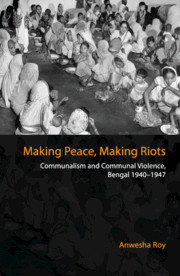Book contents
- Frontmatter
- Frontmatter
- Contents
- Maps and Figures
- Acknowledgements
- Abbreviations
- Glossary
- Introduction
- 1 The Dacca Riot, 1941
- 2 Famine 1943 – Towards a Hardening of Community Identities
- 3 From Community to Communal: The Bengal Secondary Education Bill and the Idea of Pakistan
- 4 The Great Calcutta Killing, August 1946
- 5 Noakhali Riots, October 1946
- 6 A Test of Faith: Gandhi in Noakhali and Calcutta 1946–47
- Concluding Remarks
- Appendix 1
- Appendix 2
- Appendix 3
- Appendix 4
- Bibliography
- Index
Introduction
Published online by Cambridge University Press: 23 October 2018
- Frontmatter
- Frontmatter
- Contents
- Maps and Figures
- Acknowledgements
- Abbreviations
- Glossary
- Introduction
- 1 The Dacca Riot, 1941
- 2 Famine 1943 – Towards a Hardening of Community Identities
- 3 From Community to Communal: The Bengal Secondary Education Bill and the Idea of Pakistan
- 4 The Great Calcutta Killing, August 1946
- 5 Noakhali Riots, October 1946
- 6 A Test of Faith: Gandhi in Noakhali and Calcutta 1946–47
- Concluding Remarks
- Appendix 1
- Appendix 2
- Appendix 3
- Appendix 4
- Bibliography
- Index
Summary
Let me begin with a bit of personal history. I grew up in a Bengali family that had seen the horrors of the partition of Bengal. Although I did not live in West Bengal (my father was posted in Bokaro Steel City, Jharkhand), on my frequent trips to Calcutta I was surprised to find how strong the Bengali Hindu identity there was, not just for my family, but also amongst most Bengalis living in the city. Probing deeper, I found that they consciously tried to reinforce this identity through ‘customs’, ‘traditions’, attire, food and cultural practices. Discussions about a glorious ‘Bengali’ past would often go beyond literary geniuses like Rabindranath Tagore and Sarat Chandra Chattopadhyay; equally important was to remember ‘historical’ personalities who had ‘fought’ valiantly for our freedom. Interestingly, amongst many such ‘freedom fighters’, one name would figure prominently at the top of the list – Shyama Prasad Mookerjee, the well-known leader of the Hindu Mahasabha from Bengal and, later, also the founder of the Jana Sangh. Hailed as a ‘saviour’ who prevented the Balkanization of Bengal, his politics of the Hindu Mahasabha were considered by the Calcutta Bengalis to be just and even necessary in the face of partition. In contrast, there was also a very conscious attempt to vilify Gandhi as one who had bartered away ‘India's’ integrity to appease Muslims.
My grandparents had migrated to Calcutta from East Bengal after being compelled, like many others before and after them, to flee their homeland after the partition of Bengal in 1947. The ugly communal riots had stirred their apprehensions about a future in East Bengal. I had heard stories about the Great Calcutta Killing and the Noakhali riots from my grandfather in which he would repeatedly recount how Hindus were butchered in thousands by their Muslim neighbours, and friends turned foes overnight. This perplexed me even more, because Hindus too had killed their Muslim neighbours in thousands. This selective amnesia, which I found not just among those who had witnessed the partition but also amongst the next generation who had only heard stories about it, drove me to seek an understanding of the deeper currents that ran through the formation of such apparent ‘fixed’ categories as Hindus and Muslims. I also noticed the almost instinctive exclusion of Muslims from any ideas of the ‘Bengali community’. ‘Bengali’ was always and almost matter-of-factly equated with being Hindu.
- Type
- Chapter
- Information
- Making Peace, Making RiotsCommunalism and Communal Violence, Bengal 1940–1947, pp. 1 - 25Publisher: Cambridge University PressPrint publication year: 2018

